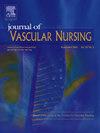Impact of peripheral artery disease on daily living: A study on knowledge, contributing factors and quality of life among patients
IF 1.2
Q3 NURSING
引用次数: 0
Abstract
Background
Peripheral artery disease (PAD) is a condition that affects blood vessels and may lead to complications such as foot or leg ulcers and gangrene. However, the level of awareness of PAD among the population of coastal Karnataka is not well known, and it is known that PAD has a significant negative impact on the quality of life of these patients. The objective of the present study was to assess knowledge, identify contributing factors, and quality of life among patients with PAD, and determine the associations between quality of life and selected demographic and clinical variables.
Methods
This hospital-based descriptive study was conducted among 202 patients with PAD. The demographic details, clinical parameters, knowledge of PAD, factors contributing to PAD, and quality of life of patients with PAD were assessed via validated data collection instruments.
Results
The mean age was 60.35 (SD=1.04) years, and 86.1% were males. Among the participants, 77.7% had undergone surgery, 13.4% had a below-knee amputation, and 2.5% had forefoot amputation. The majority of the patients (75.8%) had a moderate level of knowledge, 18.8% had good knowledge, and very few (5.4%) had poor knowledge of PAD, with a median value of 10.5 (IQR 9–12), where the IQR represents the range between the 25th and 75th percentiles of the data, capturing the middle 50% of the distribution. The contributing factors of PAD, such as advanced age (42.6%), diabetes mellitus (76.7%), hypertension (60.4%), dyslipidemia (49%), smoking (26.2%), sedentary lifestyle (11.4%) and overweight (8.4%), were present among these patients. The quality-of-life score was low in areas of self-concept and feelings, with a median value of 8.57 (IQR 0–17.14), and positive adaptation scores were high, with a median value of 51.42 (IQR 40– 54.28). An association was found between PAD quality of life and advanced age (p=0.038), rural residency (p=0.006), and the clinical diagnosis of PAD with diabetes mellitus and hypertension (p=0.021).
Conclusion
The findings are concerning, as they reveal numerous complications and a significant incidence of amputation among patients. Moreover, the patients had moderate knowledge of PAD; hence, education materials were prepared to provide knowledge to these patients. Advanced age, diabetes mellitus, hypertension, dyslipidemia, smoking, a sedentary lifestyle, and overweight were the contributing factors identified among these patients. The quality-of-life score in the areas of self-concept and feelings was low. This study strongly identifies the need for general awareness of PAD, which can be prevented by lifestyle modifications. This study highlights the need for early PAD screening to prevent complications and major cardiovascular events.
外周动脉疾病对日常生活的影响:患者知识、影响因素和生活质量的研究
外周动脉疾病(PAD)是一种影响血管并可能导致足部或腿部溃疡和坏疽等并发症的疾病。然而,沿海卡纳塔克邦人群对PAD的认识程度尚不清楚,并且已知PAD对这些患者的生活质量有显著的负面影响。本研究的目的是评估PAD患者的知识,确定影响因素和生活质量,并确定生活质量与选定的人口统计学和临床变量之间的关系。方法以医院为基础,对202例PAD患者进行描述性研究。通过验证的数据收集工具评估PAD患者的人口学细节、临床参数、PAD知识、PAD影响因素和生活质量。结果患者平均年龄60.35岁(SD=1.04),男性占86.1%。在参与者中,77.7%的人接受过手术,13.4%的人接受过膝下截肢,2.5%的人接受过前脚截肢。大多数患者(75.8%)对PAD的知识水平为中等,18.8%为良好,极少数(5.4%)对PAD的知识水平较差,中位数为10.5 (IQR 9-12),其中IQR代表数据的第25 - 75百分位数之间的范围,占分布的中间50%。老年(42.6%)、糖尿病(76.7%)、高血压(60.4%)、血脂异常(49%)、吸烟(26.2%)、久坐生活方式(11.4%)和超重(8.4%)是导致PAD的因素。生活质量在自我概念和感受方面得分较低,中位数为8.57 (IQR 0 ~ 17.14),积极适应得分较高,中位数为51.42 (IQR 40 ~ 54.28)。PAD生活质量与高龄(p=0.038)、农村居住(p=0.006)、PAD合并糖尿病和高血压的临床诊断(p=0.021)相关。结论研究结果令人担忧,因为它们揭示了患者中大量的并发症和截肢的发生率。此外,患者对PAD的认知程度一般;因此,准备了教育材料,向这些患者提供知识。高龄、糖尿病、高血压、血脂异常、吸烟、久坐不动的生活方式和超重是这些患者的影响因素。在自我概念和感觉方面的生活质量得分较低。这项研究强烈确认了对PAD的普遍认识的必要性,这种疾病可以通过改变生活方式来预防。这项研究强调了早期PAD筛查的必要性,以预防并发症和主要心血管事件。
本文章由计算机程序翻译,如有差异,请以英文原文为准。
求助全文
约1分钟内获得全文
求助全文
来源期刊

Journal of Vascular Nursing
NURSING-
CiteScore
1.40
自引率
0.00%
发文量
33
期刊介绍:
Journal of Vascular Nursing provides clinical information regarding aortic and peripheral aneurysms, upper and lower extremity arterial disease, acute and chronic venous disease, and more. Original, peer-reviewed articles present descriptions, etiologies, diagnostic procedures, medical and surgical treatment and nursing implications of vascular system disorders.
 求助内容:
求助内容: 应助结果提醒方式:
应助结果提醒方式:


